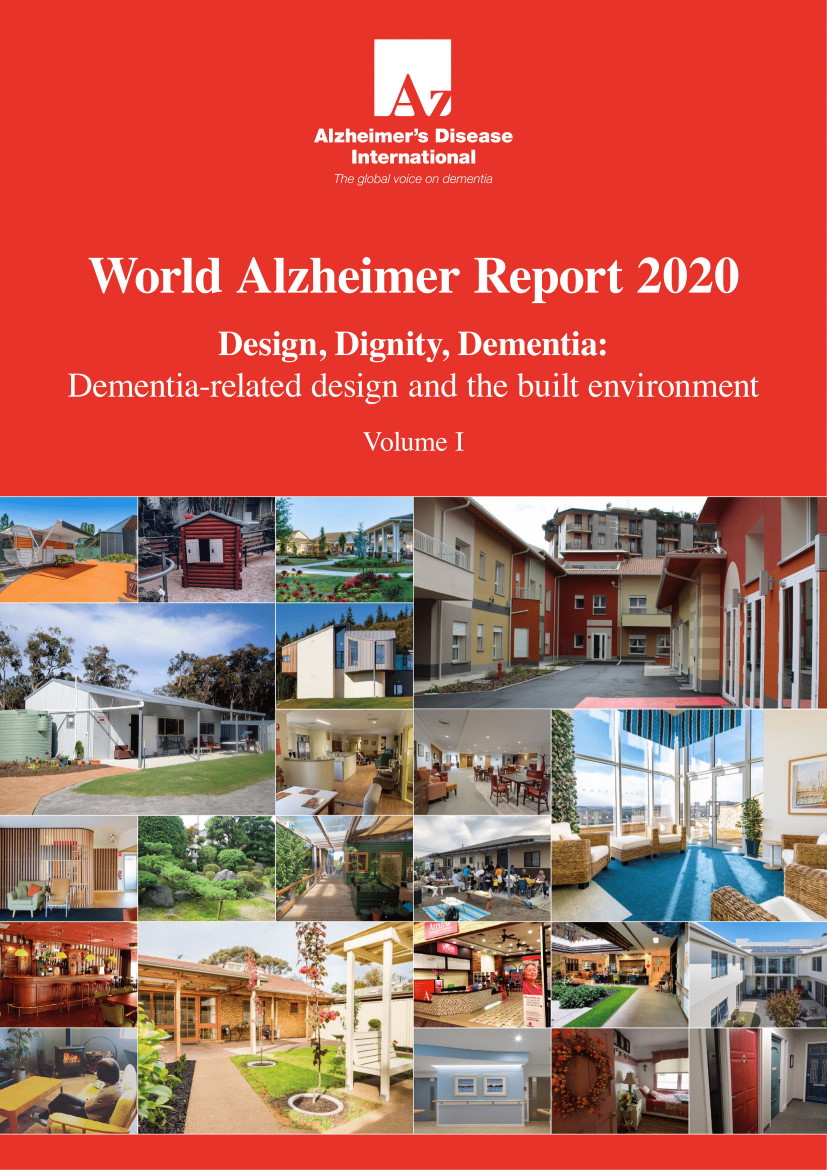- Dementia design in built environment is 30 years behind physical disabilities movement
- ADI calls on governments to embed design in their national dementia responses under the Convention on the Rights for Persons with Disabilities
- Dementia design follows simple principles, is cost effective and dramatically improves enjoyment and safety of built environment for those living with dementia
- Dementia design can enable people to live in their own homes and communities for as long as possible
- ADI launches world’s most comprehensive report on dementia and design for World Alzheimer’s Day, 21st September 2020
Drastically improved dementia design in the built environment is needed across the globe according to Alzheimer’s Disease International (ADI), who are calling on governments and multilateral bodies to overtly recognise dementia as a disability following recommendations from the world’s most comprehensive ever report into dementia-related design, World Alzheimer Report 2020: Design, Dignity, Dementia; dementia-related design and the built environment.
On World Alzheimer’s Day, ADI is calling for dementia to be more overtly recognised by governments globally as a disability, including as part of national dementia plans, to help to ensure that the therapeutic benefits of good dementia design are felt by people living with dementia at home, in residential and day-care facilities, hospitals and public buildings and spaces.
Approximately 152 million people are forecast to be living with dementia by 2050, and it is already the fifth leading cause for death worldwide, yet most countries are woefully behind in terms of making the built environment accessible for those living with dementia.
Recognising dementia as a disability will help ensure that similar strides are made for dementia design as have been made over the last 30 years by the physical disability movement, such as seeing accessible lifts, ramps, safer pedestrian crossings and the like made commonplace across the globe.
ADI’s Chief Executive, Paola Barbarino, says that dementia design provides an opportunity to adapt built environments in the same way that physical disability design has led to great innovation.
“We need to apply design guidelines and principles for people living with dementia in the same way as design guidelines are provided for people living with a physical disability,” says Barbarino. “When I was in my first job, I remember people saying that accessible lifts and ramps were impossible to install in old buildings but look at it now!”
If we can cater for those with visible disabilities, how can we refuse to cater for those with invisible disabilities? We need to start working now, with new builds, and consider this new way of thinking at planning stage, and also look at cost effective retro-fit options for older buildings.
Barbarino says that dementia design does not have to be a costly exercise and can be as simple as considering things like carpets and décor, the removal of hazards, reducing stimulation, clear wayfinding – measures that can reduce anxiety and agitation and improve social interactions.
“It comes down to simple things. I recall during a site inspection of a venue for a conference, the black areas on colourful carpets could look like holes in the floor, people living with dementia might walk around them as they could be worried of falling into them,” says Barbarino. “Things like mirrors on the walls can be an issue, as people with dementia can be disoriented by seeing their own reflection, especially at night. Design is effectively a non-pharmacological intervention, adding to the number of things we can do – in absence of a cure – to make the lives of those living with the condition easier and more fulfilling.”
Co-author of the report, Richard Fleming, says that dementia design is needed urgently, and our knowledge of how to do it has grown over the years.
“Our knowledge of how to design buildings that support people living with dementia has grown over the last forty years and we are now in a position to be more proactive in implementing it in practice,” says Fleming.
The rising number of people living with dementia requires that their needs are considered at the beginning of every building project that is likely to be used by elderly people. Dementia design should never be an afterthought.
“We need more architects and designers who are switched on to the challenges of designing for people living with dementia. This means that they should be introduced to them in their training when they are looking for areas that inspire them,” continues Fleming. “Designing for people living with dementia should be made an attractive option in the curriculum of every school of architecture and design.”
In the report, Kate Swaffer, Chair, Co-Founder and CEO of ADI’s partner Dementia Alliance International, says that the link between disability and environment is clear.
The environment’s influence in creating disability or in increasing it has been well established and is seen as integral to the definition of disability. If the environment changes, then the experience of someone living with a disability will also change.
“People with physical disabilities have made major progress as substantial, influential members of society, borne out of society’s response to changes in the built environment becoming the norm in many countries” continues Swaffer. “Yet people with dementia are still being left behind, not only in terms of health and social care but in terms of recognition of dementia as a condition causing disability. It is vital that planners, designers and architects embrace dementia-related design at the outset and include people living with dementia in the whole design process”
Covid-19 has disproportionately impacted people with dementia, with around a quarter of virus deaths in certain countries being those of people with dementia. Care facilities, where many people with dementia live, have been hard hit when exposed to the virus.
“Covid-19 restrictions implemented to protect residents in long term care may have resulted in interventions that could have accelerated physical and cognitive decline or indirectly contributed to the deaths of some residents,” says Barbarino. “Better design could have absolutely helped to minimise the spread of the virus in care facilities. Dementia design needs to be a crucial part of how countries rebuild following Covid-19.”
Recognising dementia as a disability is one of several recommendations from the World Alzheimer Report 2020, alongside the recommendation to incorporate dementia-related design into national dementia plans in response to the WHO Global action plan on the public health response to dementia 2017-2025.
“The first target in the WHO plan is for 75 percent of the Member States to have developed or updated national policies, strategies, plans or frameworks for dementia by 2025,” says Barbarino. “Presently, only 30 Member State countries out of 146 have met this goal. The analysis of these plans available through the ADI website shows that only about 25 percent of these currently include designing for people with dementia.”
Australia, England and Scotland are global leaders in dementia-related design leading the way in translating existing research into practice. Barbarino says that these are among many great examples of existing efforts to develop dementia-friendly design, pointing to the likes of Swedish furniture giant IKEA.
“In 2019, IKEA partnered with a construction company to launch flat pack housing for people living with dementia. The homes feature key elements of dementia design, including mirrorless bathrooms, old-fashioned appliances, traditional cupboard handles in kitchens, simply adapted bathrooms and importantly dementia-friendly outdoor spaces and gardens,” says Barbarino. “Their focus has been to encourage accessibility and engagement with activities that promoted socialisation and wellbeing. With over 100 simple adaptations – many dementia specific – this is an innovative new model for living independently at home for longer.”
Barbarino says that it just one such example of how dementia design can be adopted, but that ultimately it comes back to having strong national planning for the disease.
We cannot stress enough how important it is for countries to develop and implement national dementia plans, and to include dementia-friendly design into these plans. Design considerations can make a world of difference for people living with dementia, helping them to live with dignity and respect.
The principles of dementia design include:
- Unobtrusively reducing risks: Minimise risk factors such as steps and ensure safety features are as unobtrusive as possible.
- Providing a human scale: The scale of buildings can impact the behaviour of people with dementia, so provide a human scale to minimise intimidating features.
- Allowing people to see and be seen: The provision of an easily understood environment will help to minimise confusion. A literal line of sight should be clear for both residents, and staff.
- Reducing unhelpful stimulation: Environments should be designed to minimise exposure to stimuli that are unhelpful, such as unnecessary or competing noises and the sight of unnecessary signs, posters, spaces and clutter.
- Optimise helpful stimulation: Enabling the person living with dementia to see, hear and smell things that give them cues about where they are and what they can do, can help minimise their confusion and uncertainty.
- Support movement and engagement: Providing a well-defined pathway of movement, free of obstacles, can support engagement with people and opportunities.
- Create a familiar place: The use of familiar building design, furniture, fittings and colours affords people with dementia an opportunity to maintain their competence.
- Provide opportunities to be alone or with others: A variety of spaces, some for quiet conversation and some for larger groups, as well as spaces where people can be by themselves, gives people with dementia a choice to how they spend their time.
- Link to the community: The more an environment enables visitors to drop in easily and enjoy being in places that encourage interaction, the more the sense of identity that comes from spending time with loved ones and others is reinforced.
- Design in response to vision for way of life: The way of life offered needs to be clearly stated and the building designed both to support it and to make it evident to the residents and staff.
“As the number of people living with dementia rise, and young onset dementia is increasingly an issue, we need to build a world for people living with dementia, one that they and their families can all be proud of.”

